The NVIDIA GeForce GTX 650 Ti Review, Feat. Gigabyte, Zotac, & EVGA
by Ryan Smith on October 9, 2012 9:00 AM ESTPower, Temperature, & Noise
As always, we’re wrapping up our look at a video card’s stock performance with a look at power, temperature, and noise. Unlike GTX 660, GTX 650 Ti does not have GPU boost, which means the GTX 650 Ti’s load voltage is fixed at a single value. This is more important for overclocking, but because NVIDIA is not trying to min-max performance by sacrificing some power consumption, it allows the GTX 650 Ti to really turn down its power consumption. As a reminder, NVIDIA’s TDP here is 110W, with no power target (though NVIDIA throws around a “typical” number of 80W).
| GeForce GTX 650 Ti Series Voltages | |||||
| Ref GTX 650 Ti Load | EVGA GTX 650 Ti Load | Zotac GTX 650 Ti Load | Gigabyte GTX 650 Ti Load | ||
| 1.087v | 1.05v | 1.087v | 1.087v | ||
Without GPU boost voltages are quite low for desktop GeForce 600 cards. Instead of spiking at 1.175v we’re seeing a range from 1.05v to 1.087v. Meanwhile the idle voltage is typical for a GK106 card at 0.875v.
While we’re on the subject of voltages, it’s worth noting that while NVIDIA doesn’t have GPU boost active, this doesn’t mean they’ve thrown away Kepler’s power management system. Specifically there’s still a hard 1.175v ceiling, and at high voltages NVIDIA will still step down the voltage based on temperature in order to combat leakage. When overvolting our reference GTX 650 Ti we saw voltage step downs at a relatively low 56C, and another at 74C. This only applies to overvolting though, and there’s no corresponding reduction in clockspeed in any scenario.
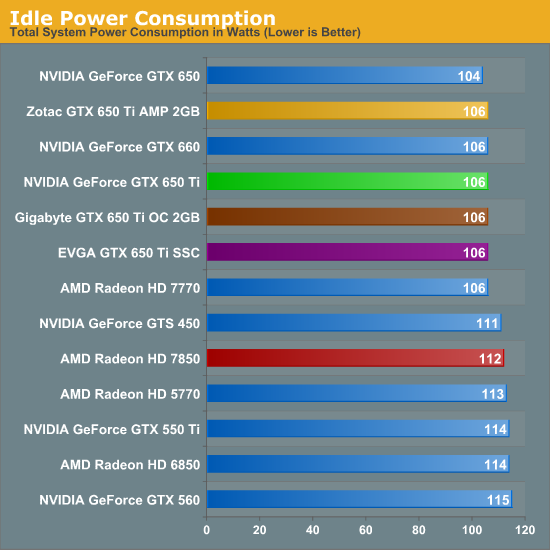
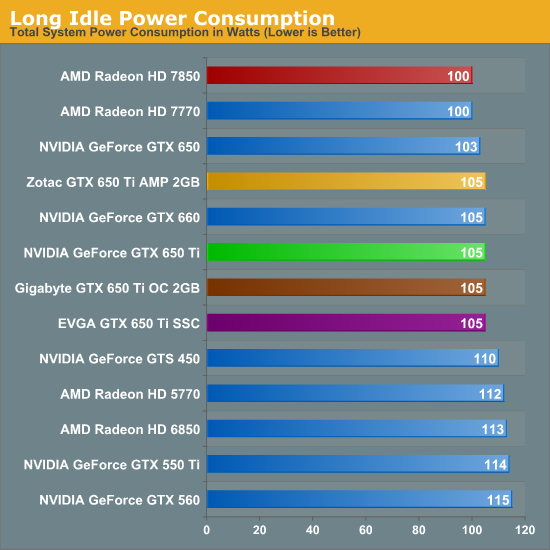
Starting as always with idle, having already seen the GK106 based GTX 660 there are no grand surprises here. Even with the disabling of some functional units the GTX 650 Ti doesn’t do any better than the full-fledged GTX 660, which is not to say that this is bad. At an NV estimated idle TDP of 5W this is still better than the 7800, and is good enough to tie the 7770. The factory overclocked cards fare no worse here either, all of which lead to our testbed hitting the same marks at the wall.
The one place NVIDIA can’t compete is in the long idle scenario with no active displays. The 7800 series still has a 5W advantage at the wall, though the benefits of something like AMD’s ZeroCore technology are not nearly as great here since the GTX 650 Ti can’t be SLI’d (and hence have a headless card).
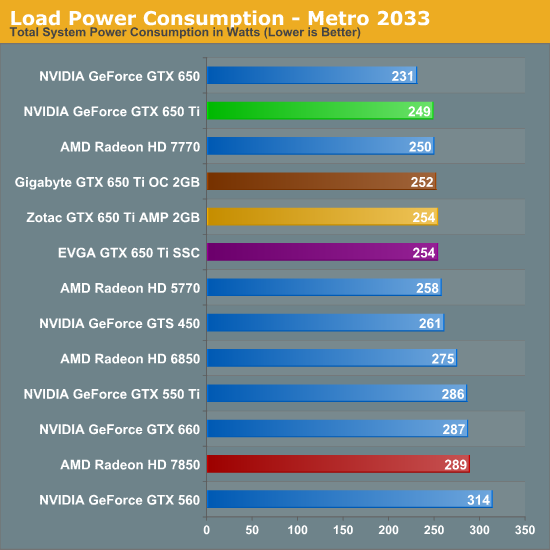
Moving on to load power consumption we’re finally seeing a test where the GTX 650 Ti has a clear architectural/design advantage over the competition. Though not strictly comparable, the 7850 has an official TDP of 150W versus 110W for the GTX 650 Ti, a difference of 40W. Meanwhile under Metro the gap between the 7850 and the GTX 650 Ti is exactly 40W (before taking into consideration PSU efficiency of course). Paper specs aside the GTX 650 Ti is clearly intended to be a lower power card than the 7850 and here it delivers. If it can’t beat the 7850 in performance then it is going to need to beat the 7850 on power consumption.
Meanwhile our factory overclocked cards present an interesting lineup. All 3 are closely clustered together in spite of the fact that the Zotac and Gigabyte cards have an extra 1GB of GDDR5 RAM to power. GDDR5 has quite the reputation for being a power hog (for a RAM), so it’s a bit surprising not to see a greater difference. The biggest driver of any power increase seems to be the overclocks themselves, leading to the marginally lower value we see for the Gigabyte card.
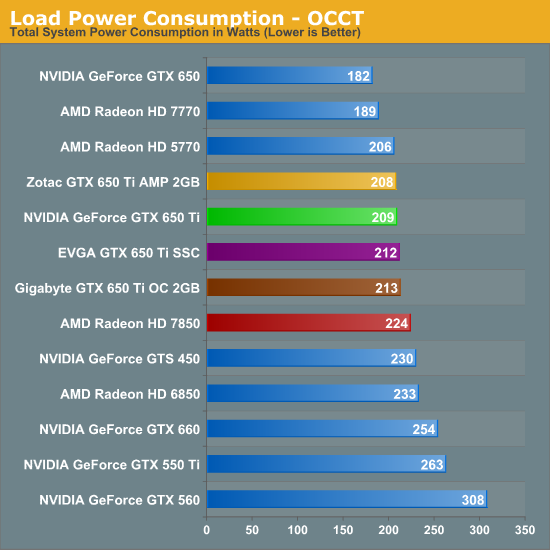
Turning to OCCT, the GTX 650 Ti doesn’t maintain the same large lead over the 7850 that it did with Metro thanks to AMD’s more aggressive throttling (and without GPU boost NVIDIA may as well not have any throttling), but reinforcing the fact that these cards are in two different power classes the GTX 650 Ti still ends up drawing less power. In fact it draws less power than the GTX 550 Ti or the GTS 450, the latter of which is not typically a high power card. Even without GPU boost – or perhaps especially without GPU boost – NVIDIA’s high power efficiency is maintained, though at a cost of rendering performance notably weaker than the immediate competition.
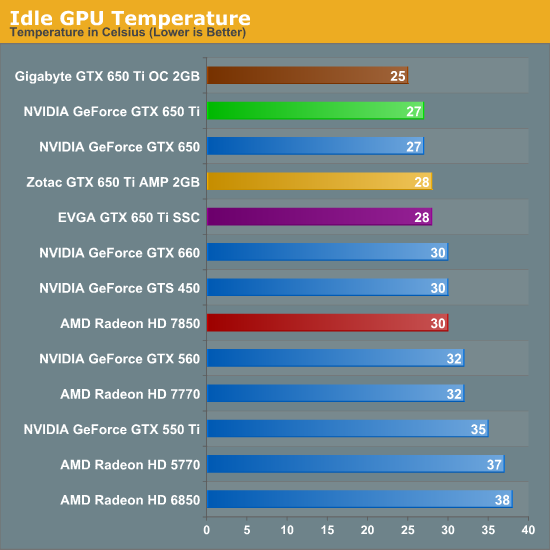
A low power GPU combined with open air coolers often leads to very low idle temperatures, and the GTX 650 Ti lives up to that tradition. It’s simply not that often that we see GPUs hit temperatures only a couple of degrees above room temperature. And in the case of Gigabyte’s card with its oversized that’s the lowest idle GPU temperature we’ve ever recorded, once more proving that there’s no kill like overkill.


Moving on to load temperatures we get to see the effectiveness of an open air cooler combined with the relatively low power consumption of the GTX 650 Ti. At 59C under Metro and 65C under OCCT our reference GTX 650 Ti holds up amazingly well, and just wait until we get to the noise readings, since this is where the GTX 650 Ti and 7850 will really stand apart. Meanwhile even with their similar designs the EVGA and Zotac cards both end up being a bit cooler, than the reference GTX 650 Ti. But the real winner is the Gigabyte card and its oversized cooler; 43C with Metro is unheard of, and 50C with OCCT is as equally impressive.

Transitioning to noise measurements we start with idle noise, where there is no great surprise as most cards have long since ceased having loud idle states. The EVGA card is a bit disappointing though, since there’s no great reason why such an open air card should be much above 41db(A).
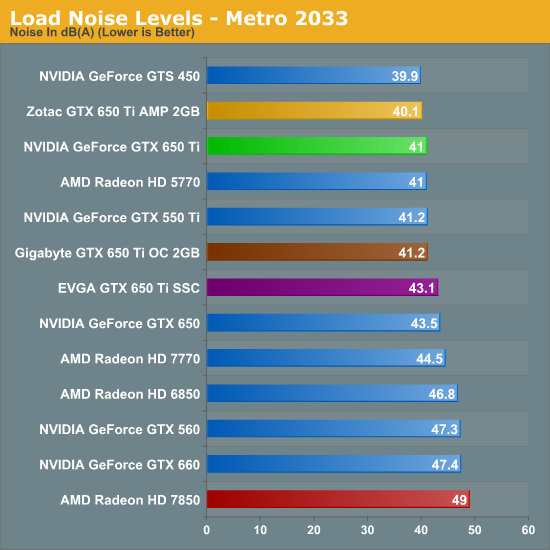
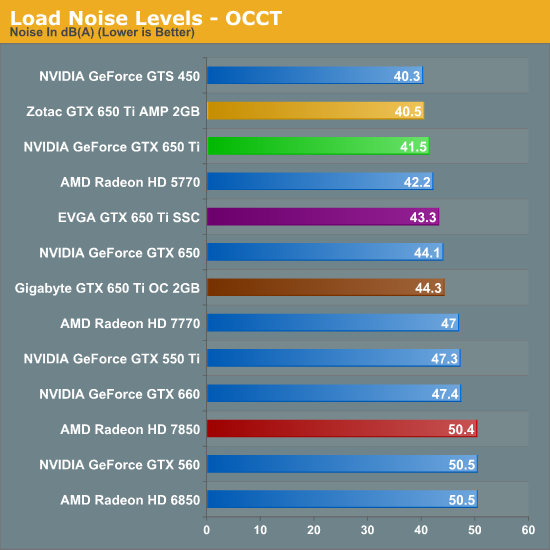
Taking a look at load noise we finally get to see the full picture. Earlier we had high praises for NVIDIA’s reference design, and this is the reason why. NVIDIA almost always hits a good balance between power, temperature, and noise, and nowhere is this more evident than with the GTX 650 Ti. Peaking at 41.5db(A) with OCCT it barely gets off of the noise floor. Meanwhile AMD’s reference 7850, complete with its blower, is almost 9dB(A) louder. Open air non-reference 7850s won’t be nearly as loud, but this is a reminder of what open air coolers can do, particularly when power consumption is low enough.
The real winner for load noise generation however is not NVIDIA’s reference design or even the Gigabyte card and its oversized cooler; it’s Zotac and their fairly plain open air cooler. Admittedly we’re looking at just a 1dB(A) difference, but if noise is crucial the Zotac card looks particularly good. Meanwhile the EVGA card, though starting out rough, doesn’t end up doing too poorly at load here. 0.3dB(A) is a tiny increase in noise over idle and it’s actually good enough to be in the middle of the pack for our retail cards.
The surprising result is the Gigabyte card, which should have the easiest time cooling. It looks like Gigabyte’s fan curve is a bit more aggressive than the rest of the GTX 650 Ti cards, which helps explain its amazingly low load temperatures, but that means there’s a noise tradeoff. Given the temperatures we’re seeing, Gigabyte was a little too aggressive with their fan curve; had they not then they could have easily swept this entire section.










91 Comments
View All Comments
CeriseCogburn - Friday, October 12, 2012 - link
Oh there's the amd fanboy bloviating spew I predicted above you responded to ! LOL I cannot frikkin believe it, I got it exactly correct without looking ! Here I will FTFamd fanboy" Don't forget, the 650Ti comes with a game and so does the 560Ti. Coming with a game is necessary just to compete right now. The 460 also has some highly factory overclocked models that can smash out the 7770 while still being cheaper. The 7850 would do better at $10 or $20 lower and a MIR is a great way to accomplish that since a lot of people forget to do them anyway, but buy the card because of the after MIR price. ( I love ripoff MIR because I am an idiot shining on for corpo pig profits I hate so much).
ionis - Wednesday, October 10, 2012 - link
2 of the 17 2GB 7850s on newegg comes with a game. I didn't bother checking the 1GB, b/c who cares about the 1GB? To say they comes with a game is a bit disingenuous.CeriseCogburn - Friday, October 12, 2012 - link
It's okay all the amd fanboys can get the lowest low down 1GB now at the cited lowdown more expensive price, that doesn't matter when they are making their arguments for amd fanboyism.Two seconds later they will be screaming the 7850 is future proof with 2g ram so F orget the 650Ti, it is also the best deal againbecause amd roxxors.
So 1gb price, and magically in the deranged gourd of the amd fanboy 2G card is futureproof.
That is the amd fanboy brain after it exited the blender 20 years ago.
Galidou - Saturday, October 13, 2012 - link
The 7850 is a better choice for one freaking big reason you Cerise wouldn't be able to see because you're blinded with green glasses. When you buy a 7850 you always have the choice to go crossfire in the future which is something that happens often in the enthusiast world.Usually GTX is branded for the enthusiast market and reffered as the better cards from Nvidia but hey, where is my SLI connector? Oh... there's none... they had to cut it for cost purposes, that's what Nvidia claims..... First time in history a GTX card comes without one... you're so stubborn you can't even see any downside when they're OBVIOUS..... HELL even half of the radeon 7770 comes with Crossfire support and some of them costs 120$...
nathanddrews - Tuesday, October 9, 2012 - link
I see what you did there...Denithor - Tuesday, October 9, 2012 - link
I caught that too. Thought it was cute but kinda silly.Wonder how much of the target audience got it?
Exodite - Tuesday, October 9, 2012 - link
I'd wager most of the AT readers passed middle school chemistry. :PPaulman - Wednesday, October 10, 2012 - link
Exodite is right. Also, nerds love memorizing trivia (and the periodic table definitely counts).CeriseCogburn - Friday, October 12, 2012 - link
I'll wager if that's minimally true we've got a dumber group than the general populace.Since the idiots group think yours was a great line, the above may in fact be the case.
chizow - Tuesday, October 9, 2012 - link
As indicated in the review, the 650Ti fills the huge gap in performance between the 7850/GTX 660 and 7770/GTX 650, its price just needs to be adjusted in light of AMD's pre-emptive cuts on the 7850. Once we start seeing ~$20 rebates similar to those we see for the 7850, the 650Ti should be a more appealing option in the sub-$150 range.I also think Nvidia missed an opportunity here by turning off Boost for sub-660 parts. It's just inconsistent with the rest of the Kepler line and while it allows partners to benefit on OC parts, they are clearly charging an additional premium instead of offering it at MSRP like past parts such as EVGA FPB.
Most interesting to me seeing how these bandwidth neutered parts perform is how shading/backend performance has caught up and is generally no longer the biggest bottleneck; bandwidth tends to hold these cards back more often than not compared to their bigger siblings even at modest resolutions like 1080p.